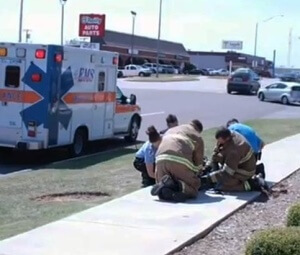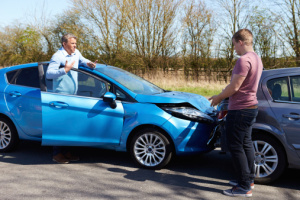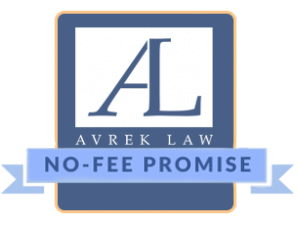“Head injury” is a very broad term used to describe injuries that occur in the scalp, skull, brain, underlying tissues, and blood vessels of the head.
These types of wounds may also receive other names such as brain injury or traumatic brain injury (TBI), depending on the severity of damage done to the head.
All head injuries are serious and require immediate medical attention, even low impact car accidents can be very dangerous.
Car accidents can be caused from speeding, poor road conditions, distracted driving, etc., but whatever the cause don’t go without help.
If you or a loved one has been injured in a car accident and suffered a head injury (mild or severe) you need to seek help immediately.
Contact Avrek Law Firm
Avrek Law has over 50 years experience and we’ve recovered over $2 Billion for our clients.
If you have been injured in a car accident please contact us today.
You can reach us 24/7 by contacting us online or calling 866-598-5548.
We help those injured in pedestrian accidents, motorcycle and bike crash, and more.

What Is a Closed Head Injury?
A closed head injury occurs when the head is hit hard, but the injury doesn’t penetrate or open the skull.
The intense force of the blow causes the brain to shake inside the skull, causing internal injuries.
This movement can cause the brain to swell, or tear and the most common closed head injury is a brain concussion.
Most brain concussions don’t result in a permanent brain injury, rather most cause loss of consciousness, depression or nausea.
Sometimes, nerves or blood vessels are also damaged.
This can cause bleeding within or around the brain.
Symptoms of a Closed Head Injury
If you have a mild concussion, you may have a slight headache or feel “not quite right”.
These symptoms are common and usually disappear after a few days up to 4 weeks later.
But, sometimes, it is possible that after a concussion you feel as if your head is not working as well as before the injury.
This is called postconmotional syndrome and Symptoms include:
- Having greater difficulty at solving problems, thinking, concentrating or remembering.
- Having headaches.
- Having changes in your sleep patterns, such as not being able to sleep or sleeping all the time.
- Having personality changes.
- Not having an interest in usual activities.
- Feeling angry or anxious for no clear reason.
- Loss of sense of taste or smell.
- Being dizzy, light-headed, or having difficulty at keeping your balance. You may find it difficult to stand or walk.
What is a Concussion?
A concussion is a head injury that can cause an instant loss of consciousness or alertness, from a few minutes to several hours after the trauma.
What is a Contusion?
A contusion is a bruise in the brain that causes bleeding and swelling inside the brain in the area of the head where the blow occurred.
What is a skull fracture?
A skull fracture is the rupture of the skull bone.
What is a Traumatic Brain Injury?
Traumatic brain injury is an injury which depends on the force of the blow received, the consequences can be more or less serious, from contusions to important neurological injuries.
The above are just some of the most common injuries and the problems they usually produce.
In all cases, regardless of their severity, each injury requires adequate and specialized rehabilitation treatment.
What is An Open Head Injury?
An open head injury is an injury to the skull with soft tissue damage to muscle fibers and skull bones.
This type of injury is dangerous and can cause a brain infection. Especially if there is an accumulation of liquid or clotted blood between the brain and bone.
In an open head injury, an object could also penetrate the skull, entering the brain.
There are many types of skull fractures commonly seen in car accidents:
- Linear skull fractures – the most common from car accidents.
- Depressed skull fractures – very serious and occurs when the force of impact presses the skull down.
- Diastatic skull fractures – occurs at the part of the skull that was fused during maturity into adulthood.
- Basilar skull fracture – the most serious fracture occurring at the base of the skull and closest to spinal cord.

Who is Liable For The Injuries?
As with other types of accidents, figuring out who is at fault in a traffic accident is a matter of deciding who had the carelessness or who the “negligent party” was.
In many cases, common sense will tell you that a driver acted negligently, but you cannot know what laws or regulations that person has violated.
Your argument to an insurance company that someone else was to blame for an accident can be strengthened if you find some “official” evidence to support this conclusion.
Here are a number of places where you can find such support.
Police reports
If the police arrived at the scene of the accident, especially if they found out that someone was injured, they probably made a report of the accident in writing.
Ask the local traffic police division about how to get a copy, and you can even fight a police report if need be.
Sometimes a police report clearly expresses the opinion of an officer about how someone specifically violated a traffic law and how this violation caused the accident.
It might even mention that the officer issued a subpoena. At other times, the report merely mentions negligent conduct, with no clear indication of the cause of the accident.
No matter how specific, any mention in a police report of a traffic law or driving violation can be a great deal of support when it comes to proving that the other person was to blame.
State Traffic Laws
Another place to seek support for your argument that the other driver was at fault is in the state laws that govern vehicular driving.
These road rules are contained in the laws of each state and are generally known as the “Vehicle Code.”
If you find a rule that can be applied to your accident, copy not only its exact words, but also the statute number, so that you can consult it precisely when negotiating your claim with the insurance company.
Responsibility “Without a doubt”
If you are involved in certain types of accidents, the other driver is guilty 99% of the time and insurance companies just bother to discuss the issue.
Here are some examples of “No Doubt” accidents.
Rear-end Collisions
If someone hits you from behind, it will almost never be your fault, regardless of why you stopped.
A basic road rule says that a vehicle must be able to stop safely if traffic stops in front of it. If you cannot stop safely, the driver going behind you is to blame.
The other crucial part of the accident claim from the rear end is to demonstrate how the damage happened: if the front end of one car is damaged and rear of the other part too, there cannot be much discussion about who hit who.
Of course, the driver of the car who hit you may file a lawsuit against someone who made you suddenly stop, or against a third car that pushed his car against yours, but that does not change his responsibility for the damage to your car.
Keep in mind, however, that even if you have been hit from behind, in some circumstances your own oversight can reduce your compensation.
A common example is when one or both of your brakes or taillights were out of service, especially if the accident happened at night.
Another example is if you had mechanical problems but failed to do everything in your power to move the vehicle off the road.
Accidents when turning left
A car that makes a left turn is almost always responsible for a collision with a car that drives in a straight direction.
Exceptions to this quasi-automatic rule are rare and difficult to prove, but can occur if:
- The car driving in a straight direction was well above the speed limit.
- The car that drives in a straight direction passed a red light.
- The car turning to the left began to turn safely, but something unexpected made it slow or stop. This is an extremely difficult exception to the rule because a basic road rule says that a car that makes a left turn must wait until it can safely complete the turn before passing in front of the traffic it circulates.
How to Gather Evidence
Stay alert and take notes about the car accident. Learn about what to do after a car accident.
Get the contact information of the other people involved and try to get information about driver’s licenses (if anyone does not own the car ask the owner’s relationship and contact data).
Talk to potential witnesses in the area to get their phones, emails and addresses. And if you can, take photos of the scene of the accident.
The info and images that you get will be very useful for the claim that you will present to your insurance company, future investigations, and when you contact a car accident lawyer to help you with your case.

Should I Hire a Lawyer?
In the United States, each state has its specific laws, rules, and regulations that can be tricky when filing claims with insurance companies and, if necessary, take legal action against the negligent party to collect money for compensation.
Therefore, in the event that you have to file an automobile accident lawsuit, it is important to contact a lawyer immediately.
You can call us 24/7 at 866-598-5548. With over 50 years experience, Avrek Law is the law firm you need to fight for you.
How much is your case worth?
Get a free case evaluation